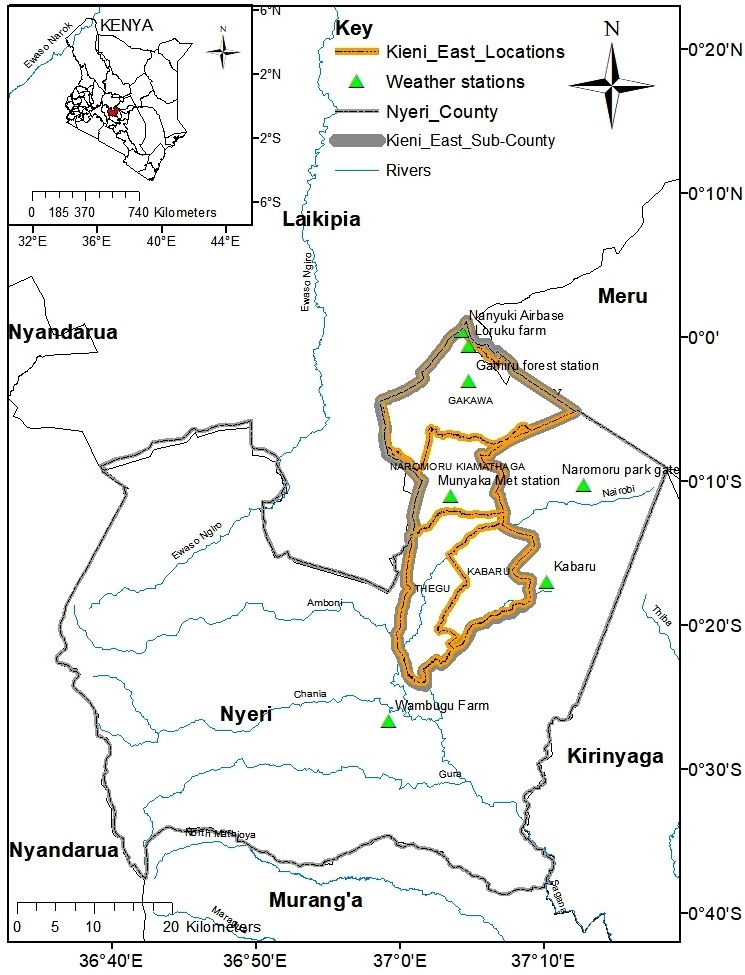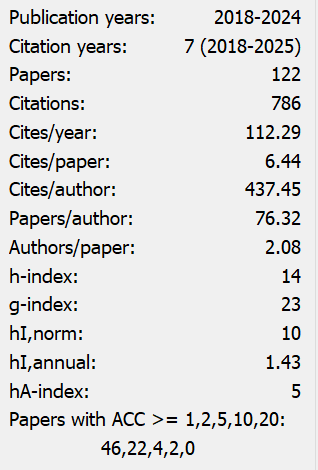Assessment of Smallholder Farmers’ Adaptive Strategies on the Effects of Seasonal Rainfall Variability on Maize Yields in Nyeri County
Abstract
Maize is the leading food crop produced in most parts of the world and a staple food crop in Kenya. Majority of the maize farmers are smallholders due to reduced land sizes as a result of land fragmentation. Maize farming is rain-fed making it more vulnerable to rainfall variability. Over the years, the farmers have increased their resilience and adaptive potential through indigenous knowledge so as to cope with the climate related risks. However, the increasing rainfall variability, frequency and more severe shocks likely surpass their current adaptive strategies. The study assessed existing adaptive strategies of the small-holder maize farmers in Kieni East sub-County in Nyeri Couny to the seasonal rainfall variability effects. The research adopted a mixed research design. Data was obtained from primary and secondary sources. Primary data was obtained using household structured questionnaires. Data was analyzed using descriptive methods and presented using charts and tables. SWOT analysis analyzed several underlying aspects affecting maize farmers in the sub-County. The study found that the farmers have several specific adaptive strategies to the effects of seasonal rainfall variability at their disposal which include but not limited to the use of varieties of maize seeds, seeking training, water harvesting, use of manure and fertilizers. Farmers also respond to rainfall variability by planting maize varieties that are early maturing and drought resistant as well as engaging in alternative farming activities and other economic activities.
References
[2] Ali, A., Yazar, A., Aal, A. A., Oweis, T. and Hayek, P. (2010). Micro-catchment water harvesting potential of an arid environment. Agricultural Water Management, 98(1), 96-104. https://doi.org/10.1016/j.agwat.2010.08.002
[3] Bancy, M. M. (2000). The influence of climate change on maize production in the semi-humid areas of Kenya. Journal of Arid Environments, 46(4), 333-334. https://doi.org/10.1006/jare.2000.0699
[4] Below, T. B., Schmid, J. C., & Sieber, S. (2014). Farmer’s knowledge and perception of climatic risks and options for climate change adaptation; a case study from two Tanzanian villages. Regional Environmental Change, 22, 223-235. https://doi.org/10.1016/j.gloenvcha.2011.11.012
[5] Bryan, E., Ringler, C., Okoba, B., Roncoli, C., Silvestri, S., & Hererro, M. (2013). Adapting Agriculture to Climate Change in Kenya: Household strategies and determinants. Journal of Environmental Management, 114, 26-35. https://doi.org/10.1016/j.jenvman.2012.10.036
[6] Claessens, L., Antle, J.M., Stoorvogel, J. J., Valdivia, R. O., Thornton, P. K., & Hererro, M. (2012). A method for evaluating climate change adaptation strategies for small-scale farmers using survey, experimental and modeled data. Agricultural Systems, 111, 85-95. https://doi.org/10.1016/j.agsy.2012.05.003
[7] Carr, E. R., Abrahams, D., Arielle, T., Suarez, P., Koelle, B. (2015). Vulnerability assessments, identity and spatial scale challenges in disaster-risk reduction. Jamba. J. Disaster Risk Stud., 7(1), 1-17. https://doi.org/10.4102/jamba.v7i1.201
[8] Cooper, P. J. M., & Coe, R. (2011). Assessing and addressing climate induced risk in Sub-Saharan rain-fed agriculture. Experimental Agriculture, 47(02), 179-184. https://doi.org/10.1017/S0014479711000019
[9] Deressa, T. T., Hassan, R. M., Ringler, C., Alemu, T., & Yesuf, M. (2009). Determinants of farmer’s choice of adaptation methods to climate change in the Nile Basin of Ethiopia. Global Environmental Change, 19(22) 248-255. https://doi.org/10.1016/j.gloenvcha.2009.01.002
[10] Di Falco, S. (2014). Adaptation to climate change in Sub-Saharan agriculture: assessing the evidence and rethinking the drivers. Eur. Rev. Agri. Econ, 41(3), 404-430. https://doi.org/10.1093/erae/jbu014
[11] Dube, T., Moyo, P., Ncube, M., & Nyathi, D. (2016). The impact of climate change on agro-ecological based livelihoods in Africa: A review. Journal of Sustainable Development, 9(1), 256-267. https://doi.org/10.5539/jsd.v9n1p256
[12] FAOSTAT. (2010). FAOSTAT Agricultural Data. Retrieved from http://www.faostat.fao.org/
[13] Fox, P., Rockstrom, J., & Barron, J. (2005). Risk analysis and economic viability of water harvesting for supplemental irrigation in semi-arid Burkina Faso and Kenya. Agricultural Systems, 83, 231-250. https://doi.org/10.1016/j.agsy.2004.04.002
[14] Gbetibouo, G. A. (2009). Understanding farmer’s perceptions and adaptations to climate change and variability: The case of Limpopo Basin, South Africa. International Food Policy Research Institute. Discussion Paper 00849.
[15] Glennerster, R., Kremer, M., Mbiti, I. and Takavarasha, K. (2011). Access and Quality in the Kenyan Education System: A Review of the Progress, challenges and Potential Solutions. Retrieved 5th July, 2012 from http://www.povertyactionlab.org/publication/access-and-quality-Kenyan-education-system.
[16] Government of the Republic of Kenya (GoK). (2009). Agricultural Sector Development Strategy (ASDS). 2009-2020. Nairobi, Kenya.
[17] Government of the Republic of Kenya (GoK). (2013). Vision2030: National Climate Change Action Plan 2013-2017. Nanyuki, Kenya.
[18] Hansen, J. W., Mason, S. J., Sun, L., & Tall, A. (2011). Review of seasonal climate forecasting for agriculture in Sub-Saharan Africa. Experimental Agriculture, 47, 205. https://doi.org/10.1017/S0014479710000876
[19] Hickey, G. M., Pelletier, B., Brownhill, L., Kamau, G. M., & Maina, I. N. (2012). Perface: Challenges and Opportunities for enhancing food security in Kenya. Food Security, 4, 333-340. https://doi.org/10.1007/s12571-012-0203-2
[20] Hoang, M. H., Namirembe, S., van Noordwijk, M., Catacutan, D., Öborn, I., Perez-Teran, A. S., Nguyen, H.Q., & Dumas-Johansen, M. K. (2014). Farmer Portifolios, Strategic Diversity Management and Climate Adaptation: Implications for Policy in Vietnam and Kenya. Climate and Development, 6(3), 216-225. https://doi.org/10.1080/17565529.2013.857588
[21] Humphrey, A. (2004). SWOT analysis method and examples, with free SWOT template. Retrieved 12q August 2013 from http://www.businnessballs.com/swotanalysisfreetemplate.htm
[22] IPCC. (2014). Climate Change (2014). Impacts, Adaptation and Vulnerability: Contribution of Working Group II to the IPCC Fifth Assessment Report. Cambridge University Press, Cambridge.
[23]Jaetzold, R., Schmidt, H., Hornet, Z. B., & Shisanya, C. A. (2007). Farm Management Handbook of Kenya Vol. 2, (2nd Edition). Central Ministry of Agriculture and GTZ, Nairobi.
[24] Jain, M., Naeem. S., Orlove, B., Modi, V., & DeFries, R. S. (2015). Understanding the causes and consequences of differential decision-making in adaptation research: adapting to a delayed monsoon onset in Gujarat, India. Global Environmental Change, 31, 98-109. https://doi.org/10.1016/j.gloenvcha.2014.12.008
[25] Kabubo-Mariara, J., & Fredrick, K. K. (2007). The economic impact of climate change on Kenyan crop agriculture. A Ricardian approach.” Global and planetary change 57 (3): 319-330. https://doi.org/10.1016/j.gloplacha.2007.01.002
[26] KEPHIS (Kenya Plant Health Inspectorate Services). (2015). National Crop Variety List-Kenya. Retrieved November 17, 2015 from http://www.kephis.org/images/VarietyList/updatejuly2015.pdf
[27] KNBS. (2010). Population and Housing Census, Nairobi: Kenya Central Bureau of Statistics.
[28] Kuyiah, J. W. (2007). Economic analysis of smallholder agricultural production under conditions of risk: the case of Vihiga and Kilifi Districts in Kenya. MSC Thesis, Egerton University, Kenya.
[29] Le Dang, H., Li, E., Bruwer, J., & Nuberg, I. (2013). Farmers’ perceptions of climate variability and barriers to adaptation:lessons learned from an exploratory study in Vietnam. Mitigation and Adaptation Strategies for Global Change, 19, 531-548. https://doi.org/10.1007/s11027-012-9447-6
[30] Micah, B., & Absalom, M. (2014). Factors Influencing the Choice pf Climate Change Adaptation Strategies by Households: A case of Mpolonjeni Area Development Programme (ADP) in Swaziland. Journal of Agricultural Studies, 2(1), 2166-0379. https://doi.org/10.5296/jas.v2i1.4890
[31] Mintewab, B., Abe, D. B., Zenebe, G., & Livousew, B. (2013). Social Capital, climate change and soil conservation investment: panel data evidence from the Highlands of Ethiopia. Grantham Research Institute on Climate Change and the Environment. Working Paper No.115.
[32] MoALF. (2016). Climate Risk Profile for Nyeri. Kenya County Climate Risk Profile Series. The Kenya Ministry of Agriculture, Livestock and Fisheries (MoALF), Nairobi, Kenya.
[33] Momanyi, S., Mutai, N., & Bii, J. (2012). Attracting young people to farming. Agfax. Reporting science in Africa.
[34] Moock, P. (1973). Managerial ability in small-farm production: an analysis of maize yields in the Vihiga Division of Kenya. PhD Thesis (published) Columbia University, USA.
[35] Mohajan, H. K. (2014). Food and nutrition scenario of Kenya. American Journal of Food and Nutrition, 2(2), 28-38.
[36] Muga, M. (2010). Climate Change: A Major Challenge and Revelation for EA Nationals. A Journal on Resource, Reflection and Discourse for Sustainable Development, 32, 201-207.
[37] Ndegwa, W., Rao, K. P. C., Hgugi, R. K., & Kwena, K. (2010). Improving farmer adaptive capacity by integrating local and indigenous knowledge in climate forecasting and adaptive response. Adaptation Insights, 4. Retrieved from http://www. idrc.ca/EN/Programs/Agriculture_and_the_Environment/Climate_Change_and_Adaptation_in_Africa/Documents/ Adaptation-Insights-Kenya-local-climate-forecasting.pdf
[38] Newsham, A. J., & Thomas, D. S. G. (2011). Knowing, farming and climate change adaptation in North-Central Namibia. Global Envi ronmental Change, 21(2), 760-770. https://doi.org/10.1016/j.gloenvcha.2010.12.003
[39] Niang, I., Ruppel, O. C., Abdrado, M., Essel, A., Lennard, C., Padgham, J. et al. (2014). “Africa” in Climate Change 2014: Impacts, adaptations, and vulnerability. In: Contribution of Working Group II to the Fifth Assessment Report of the Intergovernmental Panel on Climate Change (pp 1199-1265). Cambridge/New York: Cambridge University Press.
[40] Odame, H. H., Hafkin, N., Wesseler, G., & Boto, I. (2002). Gender and Agriculture in the Information Society. International Service for National Agricultural Research Briefing Paper no. 55. The Hague, Netherlands: ISNAR.
[41] Ofuoku, A. U. (2013). Rural farmers’ perception of climate change in central agricultural zone of Delta State, Nigeria. Indonesian Journal of Agricultural Science, 12(2), 63-69. https://doi.org/10.21082/ijas.v12n2.2011.63-69
[42] Ogalleh, S., Vogl, C., Eitzinger, J., & Hauser, M. (2012). Local Perceptions and Responses to Climate Change and Variability: The case of Laikipia District, Kenya. Sustainability, 4, 3302-3325. https://doi.org/10.3390/su4123302
[43] Ogola, O., Milton, W., Ayieko, A., Orawa O., & Kimani, W. (2011). Analysis of fertilizer use in potato production in Nakuru district, Kenya. Africa Journal of Agriculture, 6(16), 3672-3677.
[44] Orindi, V. A., & Ochieng, A. (2005). Seed Fairs as a Drought Recovery Strategy in Kenya. Institute of Development Studies, 36(4), 87-102. https://doi.org/10.1111/j.1759-5436.2005.tb00236.x
[45] Osbahr, H., Dorward, P., Stern, R., & Cooper, S. (2011). Supporting agricultural innovation in Uganda to respond to climate risk: Linking climate change and variability with farmer perceptions. Experimental Agriculture, 47, 293-316. https://doi.org/10.1017/S0014479710000785
[46] Peacock, C., Jowett, A., Dorward, A., Poulton, C., & Urey (2004). Reaching the poor: A call to Action, Investment in Smallholder Agriculture in Sub-Sahara Africa. London: Farm-Africa.
[47] Rurinda, J., Mapfumo, P., van Wijk, M. T., Mtambanengwe, F., Rufino, M.C., Chikowo, R., & Giller, K. E. (2014). Comparative assessment of maize, finger millet and soghurm for household food security in the face of increasing climatic risk: European Journal of Agronomy, 55, 29-41. https://doi.org/10.1016/j.eja.2013.12.009
[48] Simelton, E., Quinn, C. H., Batisani, N., Dougill, A. J., Dyer, J. C., Fraser, E. D. G., Mkwambisi, D., Sallu, S., & Stringer, L. C. (2013). Is rainfall really changing? Farmer’s perceptions, meteorological data, and policy implications. Climate and Development 5, 123-138. https://doi.org/10.1080/17565529.2012.751893
[49] Sombroek, W. G., Braun, H. M. H., & van der Pouw, B. J. A. (1982). Exploratory soil map and agro-climatic zone map of Kenya.E.I Report. Kenya Soil Survey, Nairobi, Kenya.
[50] Spielman, D. J., Kelemwork, D., & Alemu, D. (2011). Seed, Fertilizer and Agricultural Extension in Ethiopia. Ethiopian strategy support program (ESSP II), Working Paper 20. International Food Policy Research Institute, Washington, D.C. Smit, B., Wandel, J. (2006). Adaptation, adaptive capacity and vulnerability. Global Environmental Change, 61, 282-292. https://doi.org/10.1016/j.gloenvcha.2006.03.008
[51] Syomiti, M., Maranga, E., Obwoyere, G., Getachew, G., Dana, H., Beatrice, M., et al. (2015). The adaptive and coping strategies of pastoralists to climate change in Baringo, Laikipia and Nyeri Counties of Kenya. Livestock Res. Rural Dev., 27, 248.
[52] Thornton, P. K., Jones, Alagarswamy, G., Andresen, J., & Herrero, M. (2010). Adaptation to climate change: Agricultural system and household impacts in East Africa. Agricultural Systems, 103, 73-82. https://doi.org/10.1016/j.agsy.2009.09.003
[53] Tittonel, P., Corbeels, M., van Wijk, M. T., Vanlauwe, B., & Giller, K. E. (2008). Combining Organic and Mineral Fertilizers for Integrated Soil Fertility Management in Smallholder Farming Systems of Kenya: Explorations Using the Crop-Soil Model FIELD. Agronomy Journal, 100, 1511-1526. https://doi.org/10.2134/agronj2007.0355
[54] Tittonel, P., & Giller, K. E. (2013). When yield gaps are poverty traps: The paradigm of ecological intensification in African smallholder agriculture. Field Crops Research, 143, 76-90. https://doi.org/10.1016/j.fcr.2012.10.007
[55] UNDP. (2010). Gender Climate Change and Community Based Adaptation. UNDP, New York.
[56] UNEP. (2011). Towards a Green Economy: Pathway to Sustainable Development and Poverty Eradication, United Nations Environment Programme. Retrieved from http://www.unep.org/green-economy
[57] USAID. (2010). Staple Foods Value Chain Analysis Country Report-Kenya. January, 2010.
[58] Waha, K., Muller, C., Bondeau, A., Dietrich, J. P., Kurukulasuriya, P., Heinke, J., & Lotze-Campen, H. (2013). Adaptation to climate change through the choice of cropping system and sowing date in Sub-saharan Africa. Global Environmental Change, 23, 130-143. https://doi.org/10.1016/j.gloenvcha.2012.11.001
[59] Wamicha, W. N. (1993). Soil Erosion Hazards in Kieni Division, Kenya.
[60] Wood, S. A., Jina, A. S., Jain, M., Kristjanson, P., & De Fries, R. S. (2014). Smallholder farmer cropping decisions related to climate variability across multiple regions. Global Environmental Change, 25, 163-17. https://doi.org/10.1016/j.gloenvcha.2013.12.011


This work is licensed under a Creative Commons Attribution 4.0 International License.
Copyright for this article is retained by the author(s), with first publication rights granted to the journal.
This is an open-access article distributed under the terms and conditions of the Creative Commons Attribution license (http://creativecommons.org/licenses/by/4.0/).


























